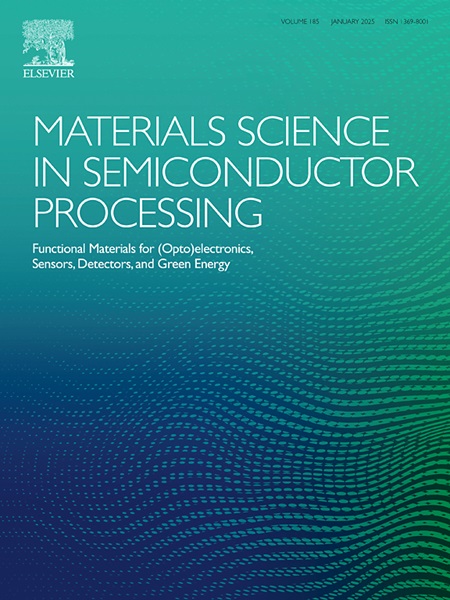Ag和pd修饰的YVO4: Bi3+纳米荧光粉的发光强度和测温性能
IF 4.6
3区 工程技术
Q2 ENGINEERING, ELECTRICAL & ELECTRONIC
引用次数: 0
摘要
在本研究中,我们报道了不同浓度Ag和Pd修饰的Y0.99VO4:0.01Bi3+纳米荧光粉的合成和综合表征。x射线衍射分析证实,所有样品均为纯四方YVO4相结晶。场发射扫描电镜图像显示单分散的球形颗粒,尺寸分布均匀。光致发光激发光谱表现为宽波段,最大波长为306 nm,而发射光谱在567 nm处表现为宽黄色波段。值得注意的是,观察到贵金属修饰的影响,1 mol% Ag/Y0.99VO4:0.01Bi3+和0.5 mol% Pd/Y0.99VO4:0.01Bi3+样品的发光强度分别比未修饰的Y0.99VO4:0.01Bi3+高约2倍和3倍。pd修饰的样品在149°C时的最大相对灵敏度为2.0%°C - 1,而ag修饰的样品在92°C和室温(~ 27°C)时的灵敏度分别为1.75%°C - 1和1.23%°C - 1。这些发现强调了金属修饰的Y0.99VO4:0.01Bi3+纳米荧光粉在成像应用中的潜力。本文章由计算机程序翻译,如有差异,请以英文原文为准。
Enhanced luminescent intensity and the thermometric properties of Ag and Pd-decorated YVO4: Bi3+ nanophosphors
In this study, we report on the synthesis and comprehensive characterization of Y0.99VO4:0.01Bi3+ nanophosphors decorated with different concentrations of Ag and Pd nanoparticles. X-ray diffraction analysis confirmed that all the samples crystallized in the pure tetragonal YVO4 phase. Field emission scanning electron microscopy images revealed monodispersed spherical particles with uniform size distribution. Photoluminescent excitation spectra exhibited a broad band with a maximum of 306 nm, while the emission spectra displayed a broad yellow band at 567 nm. Notably, the effects of noble metal decorations were observed, with both 1 mol% Ag/Y0.99VO4:0.01Bi3+ and 0.5 mol% Pd/Y0.99VO4:0.01Bi3+ samples demonstrating luminescent intensities approximately two-fold and three-fold higher than the undecorated Y0.99VO4:0.01Bi3+, respectively. The Pd-decorated sample exhibited a maximum relative sensitivity of 2.0 % °C−1 at 149 °C, while the Ag-decorated sample showed a sensitivity of 1.75 % °C−1 at 92 °C and 1.23 % °C−1 at room temperature (∼27 °C). These findings underscore the potential of metal-decorated Y0.99VO4:0.01Bi3+ nanophosphors for imaging applications.
求助全文
通过发布文献求助,成功后即可免费获取论文全文。
去求助
来源期刊

Materials Science in Semiconductor Processing
工程技术-材料科学:综合
CiteScore
8.00
自引率
4.90%
发文量
780
审稿时长
42 days
期刊介绍:
Materials Science in Semiconductor Processing provides a unique forum for the discussion of novel processing, applications and theoretical studies of functional materials and devices for (opto)electronics, sensors, detectors, biotechnology and green energy.
Each issue will aim to provide a snapshot of current insights, new achievements, breakthroughs and future trends in such diverse fields as microelectronics, energy conversion and storage, communications, biotechnology, (photo)catalysis, nano- and thin-film technology, hybrid and composite materials, chemical processing, vapor-phase deposition, device fabrication, and modelling, which are the backbone of advanced semiconductor processing and applications.
Coverage will include: advanced lithography for submicron devices; etching and related topics; ion implantation; damage evolution and related issues; plasma and thermal CVD; rapid thermal processing; advanced metallization and interconnect schemes; thin dielectric layers, oxidation; sol-gel processing; chemical bath and (electro)chemical deposition; compound semiconductor processing; new non-oxide materials and their applications; (macro)molecular and hybrid materials; molecular dynamics, ab-initio methods, Monte Carlo, etc.; new materials and processes for discrete and integrated circuits; magnetic materials and spintronics; heterostructures and quantum devices; engineering of the electrical and optical properties of semiconductors; crystal growth mechanisms; reliability, defect density, intrinsic impurities and defects.
 求助内容:
求助内容: 应助结果提醒方式:
应助结果提醒方式:


